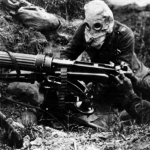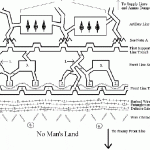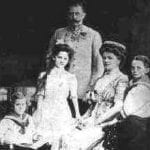The following article on the Battle of Chateau-Thierry is an excerpt from H.W Crocker III’s The Yanks Are Coming! A Military History of the United States in World War I. It is available for order now from Amazon and Barnes & Noble.
With the arrival of the U.S. marines, and their support of the beleaguered French military, the misshapen croissant of Belleau Wood (located less than 40 miles from Paris) had been taken in 1918. The American performance there had impressed the Germans. German intelligence noted, “The Second American Division [Army and Marines] must be considered a very good one and may even perhaps be reckoned as a storm troop. The different attacks on Belleau Wood were carried out with bravery and dash. The moral effect of our gunfire cannot seriously impede the advance of the American infantry. . . . The qualities of the men individually may be described as remarkable. . . . [T]he words of a prisoner are characteristic—‘We kill or we get killed.’”
Still, “Hell Wood,” as the Marines took to calling the Bois de Belleau, was only one spinney of concentrated horror in a massive field of battle. Throughout the spring and summer, it was the Germans who had advanced, not the Allies, and where the German army had faltered, it was only because it had outrun General Ludendorff’s ability to reinforce and supply it. It had also, however, suffered a million casualties and was enduring an epidemic of influenza. Still, Ludendorff was determined to make good his gains and was convinced the Allies were in no condition to strike back. He had one of his best generals, Oskar von Hutier, expand the German salient into France until he was halted by a French counterattack. By the end of the second week of July, the Allied front line appeared to have stabilized. It had stabilized for the Second Battle of the Marne.
They prepared for a counter-assault. It would happen in July and be known as the Battle of Chateau-Thierry.
Preparing for the Battle of Chateau-Thierry
Ludendorff intended, yet again, to separate the British army from the French—to isolate the British Expeditionary Force and annihilate it, while continuing to threaten Paris. On 15 July 1918, the Germans struck through the gap between Château-Thierry and the Argonne Forest— a geographic decision that would determine the site of the Battle of Chateau-Thierry. The French knew they were coming; captured German prisoners had divulged all. A week before the German attack, on 7 July, the French general Henri Gouraud rallied his army with a message to rival Haig’s “backs to the wall” order of 11 April:
We may be attacked at any moment. You all know that a defensive battle was never fought under more favorable conditions. You will fight on terrain that you have transformed into a redoubtable fortress. . . . The bombardment will be terrible. You will stand it without weakening. The assault will be fierce. . . . In your hearts beat the brave and strong hearts of free men. None shall look to the rear; none shall yield a step. . . . Each shall have but one thought, to kill, to kill plenty. . . . Your General says to you, ‘You will break this assault and it will be a glorious day.’
The power of these words is intensified if one remembers that the French general, the youngest in the army (forty-six when promoted brigadier, now fifty), was commanding a sector stretching from Verdun to Amiens. He was a dashing veteran of Africa, from which he carried a limp, his right sleeve (the arm sacrificed at Gallipoli) pinned to his uniform, his beard a flaming red, his kepi at a rakish tilt. General Harbord said of him, “His manner, his bearing and address more nearly satisfied my conception of the great soldiers of the First Empire than any other commander I met in France.”
When Gouraud referred to the French positions as a “redoubtable fortress,” it was not a mere rhetorical sally. He had put into practice General Pétain’s doctrine of defense-in-depth: a front line of trenches packed with mines and mustard gas, meant to absorb the terrible German bombardment, and a line of isolated machine gun squads to direct responding artillery fire and alert the stronger subsidiary lines of the coming German assault—though in this case the Allied artillery struck first, on the night of 14–15 July. For weeks, the Germans and Americans had tried small raids across the Marne to capture prisoners until this full-scale collision. Now the Allied shelling was so fierce that some of the assembling German units were devastated and had to be replaced, a blow that more than made up for the risk of revealing the Allied gun placements. Gouraud assumed the enemy would try to force his way down the road to Châlons-surMarne. He entrusted the defense of that road to the American 42nd Division. Pershing doubted the 42nd was ready; Gouraud had no such doubts, faith that was seen at the Battle of Chateau-Thierry.
When battle came, the French and Americans in this sector bent but didn’t break. They fell back no more than four miles, and the Germans, seeing that their offensive was kaput and under threat of counterattack, gave up trying to dislodge them. A French major who saw the 42nd “Rainbow” Division in action wrote, “The conduct of American troops has been perfect and has been greatly admired by French officers and men. Calm and perfect bearing under artillery fire, endurance of fatigue and privations, tenacity in defense, eagerness in counterattack, willingness to engage in hand-to-hand fighting—such are the qualities reported to me by all the French officers I have seen.”
The Germans pounded the regiment for two days and charged into the Surmelin Valley—to no avail; in fact, to the near annihilation of some German units, such as the Sixth Grenadiers, who entered the battle with 1,700 men and left it with 150. American rifle fire was deadly accurate, and as at Belleau Wood, the Germans were occasionally dismayed at the Americans’ fearsome appetite for battle, an appetite that began with Colonel McAlexander himself, who issued orders stating, “Don’t let anything show itself on the other side [of the Marne] and live.”
The Germans did breach the Marne and push forward as much as three miles, but their hopes of racing to Paris were thwarted—in large part by McAlexander’s stubborn defense of the Surmelin Valley. The Germans’ great dash, the Friedensturm (“Peace Offensive”) to end the war in Paris, was over. The American 3rd Division’s valor, and the 38th Infantry’s in particular, won it the battle moniker “the Rock of the Marne.”
Hardships in the Battle of Chateau-Theirry
General Ferdinand Foch, the supreme Allied commander, or generalissimo, believed German Gen. Ludendorff had shot his bolt. He ordered a counterattack against the bulge in the German line along the Marne. The Franco-American assault would be a western flank attack through the Retz Forest between Soissons and Château-Thierry. In the front line was the newly organized American IV Corps, incorporating the 1st and 2nd Divisions, under the command of Major General Robert Lee Bullard. Bullard in turn would be serving under the direction of the French general Charles Mangin, commander of the French Tenth Army.
Mangin acquired nine American divisions—more than three hundred thousand men—to support his offensive, launched on 18 July 1918. It was a tribute to the fighting prowess of the 1st and 2nd Divisions that they were at the far left of the line, pointed to lead the attack at Soissons. Between the Americans was the 1st Moroccan Division, a polyglot array of Senegalese, French Foreign Legionnaires, Arabs, and assorted international riff-raff who wore fezzes and knew how to fight. Behind Belleau Wood were the 26th, 42nd, 4th, and 77th Divisions. At the Battle of Château-Thierry, marking the center of the German salient that was to be dissolved, were the American 3rd, 28th, and 32nd Divisions.
in the run-up to the Battle of Chateau-Thierry, the American divisions hurried into their lines, hard marched, amid pouring rain, without much in the way of intelligence about the German dispositions before them, or even where they were going, and without much in the way of supplies, lacking ammunition, grenades, mortars, and machine guns; some hadn’t slept or eaten for twenty-four or even forty-eight hours. Secrecy and last-minute haste were the watchwords. This was a French show, the battle plan depended on surprise, and the Americans were to be its shock troops, moving behind a rolling artillery barrage rather than a long preparatory bombardment. The big guns sounded off at 4:35 a.m. The Americans advanced, officers to the front, taking heavy casualties, including, before the battle was over, every battalion commander of the 26th Infantry. Junior officers and sergeants filled the breach, and the soldiers did not waver, even as the casualties stacked up to fifty thousand men.
The American advance was swift—they had achieved surprise and struck in greater force in the Battle of Chateau-Thierry than the Germans could have expected— and confused, as units became mixed in the chaos of fiercely contested battle, which included German gas, artillery, and air attacks, over ground the Americans had not, of necessity, scouted beforehand. At least it was no battle of static trenches (though shallow trenches were dug and ducked into) but of open field maneuver, with French tanks in occasional support (they were lightning rods for German artillery); and the doughboys took a perhaps unwise pride in their ability to directly charge and overwhelm German machine gun nests when flanking them might have been less costly. But it was this aggressive spirit that made the doughboys what they were—and that made them think the French were often slow and unreliable. If élan had been beaten out of the poilus, it was still brimming over in the Americans.
The Germans remained disciplined, resolute opponents. They had given ground the first day in the Battle of Chateau-Thierry, but their fighting retreat stiffened on the second day. By the third, some doughboy units and officers had been pushed to the point of exhaustion. General Summerall met with his regimental commanders to assess their situations and encourage them. Colonel Frank Parker of the 18th Infantry told him, “General, my regiment has lost 60 percent of its officers, nearly all of its non-commissioned officers and most of its men and I don’t think that’s any way to treat a regiment.” According to Parker, Summerall replied, “Colonel, I did not come here to have you criticize my orders or to tell me your losses. I know them as well as you do. I came here to tell you that the Germans recrossed the Marne last night and are in full retreat and you will attack tomorrow morning at 4:30.” Parker said he never again questioned Summerall’s orders.
“BATTLES ARE WON BY REMNANTS”
The Battle of Chateau-Thierry—wrapped up, at least in the history books, on 22 July—was the turning point of the war. George Marshall called it exactly that; Pershing compared it to Gettysburg; and German chancellor Georg Hertling offered independent confirmation of how the Battle of Chateau-Thierry had changed the war: “At the beginning of July, 1918, I was convinced, I confess it, that before the first of September our adversaries would send us peace proposals. . . . We expected grave events in Paris for the end of July. That was on the 15th. On the 18th even the most optimistic of us knew that all was lost. The history of the world was played out in three days.” Ludendorff could not lunge again to destroy the British army. He had used up his reserves extracting his men from across the Marne.
The American experience of the Battle of Chateau-Thierry was not merely one of victory—but also of what victory cost. To the question what price glory, General Hanson Ely could answer, “Men must be trained that when they have been in battle for days and nights, when perhaps they have been badly handled by the enemy and have had heavy casualties, yet when the signal comes to go they will go again to the limit of their endurance. . . . it is the last five percent of the possible exertion that often wins the battle . . . not the first attack nor the second or the third, but it was that last straggling fourth attack. . . . battles are won by remnants, remnants of units, remnants of material, remnants of morale, remnants of intellectual effort.”
The Americans had proved beyond doubt at the Battle of Chateau-Thierry they had the grit to see things through.
This article is part of our extensive collection of articles on the Great War. Click here to see our comprehensive article on World War 1.
 |
 |
 |
This article is from the book The Yanks Are Coming! A Military HIstory of the United States in World War I © 2014 by H.W Crocker III. Please use this data for any reference citations. To order this book, please visit its online sales page at Amazon or Barnes & Noble.
You can also buy the book by clicking on the buttons to the left.
Cite This Article
"The Battle of Chateau-Thierry" History on the Net© 2000-2024, Salem Media.
July 27, 2024 <https://www.historyonthenet.com/battle-of-chateau-thierry>
More Citation Information.









